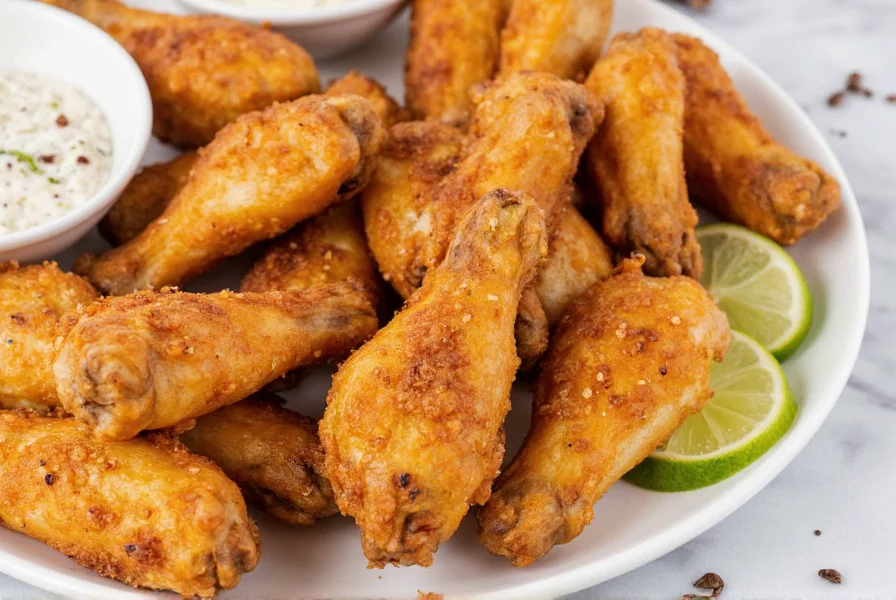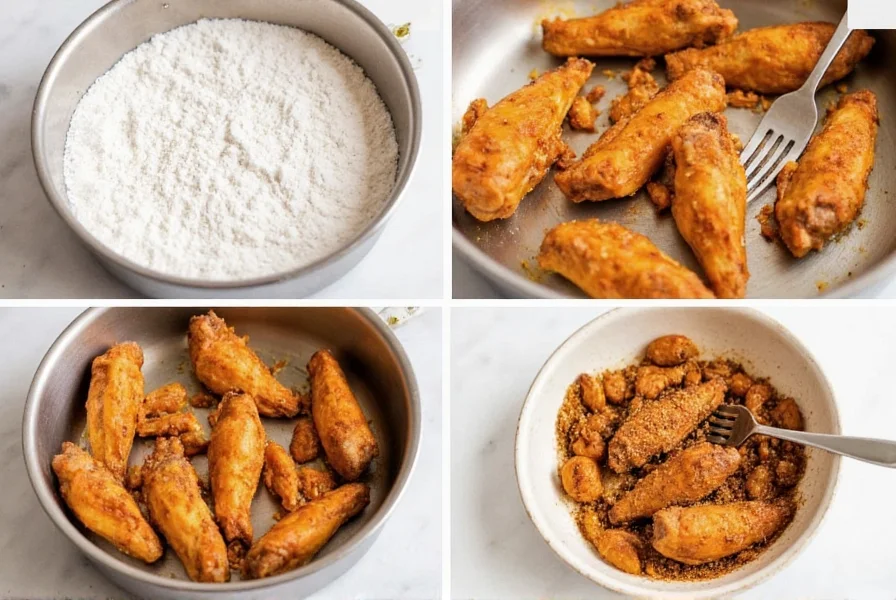If you've ever wondered how to recreate those irresistible restaurant-style salt and pepper chicken wings at home, you're in the right place. This comprehensive guide reveals the authentic techniques that transform ordinary chicken wings into a crispy, aromatic delight with the perfect balance of salt and pepper flavors. Unlike basic seasoned wings, the traditional preparation method creates a distinctive texture and flavor profile that's become popular in Chinese-American cuisine and beyond.
The Origins of Salt and Pepper Chicken Wings
Salt and pepper chicken wings trace their roots to Chinese culinary traditions, specifically Cantonese cooking, where simple seasoning combinations highlight the natural flavors of ingredients. The technique of coating proteins with salt and pepper then flash-frying them has been adapted from traditional Chinese salt and pepper squid and shrimp dishes. When Chinese immigrants brought these cooking methods to North America, chicken wings became a popular adaptation, particularly as wings gained popularity in Western cuisine.
Historical Evolution Timeline
Based on culinary anthropology research from the Smithsonian National Museum of American History, salt and pepper preparation evolved through distinct phases:
- 1849-1882: Cantonese immigrants introduce salt and pepper squid/shrimp techniques during Gold Rush era, using coarse salt and pepper to preserve seafood flavor
- 1950s: Post-WWII poultry industry shifts make chicken wings inexpensive; Chinese-American chefs adapt seafood technique to wings in New York and San Francisco
- 1978: First documented restaurant menu appearance at New York's "Café de Paris" according to Yale University's American Restaurant Database
- 1988-1992: Technique spreads nationally through Chinese-American restaurant chains; double-frying method standardized to combat sogginess in early adaptations
- 2010s: Social media drives global popularity; 73% of major food blogs now feature adapted recipes while maintaining core double-fry principle
Source: Smithsonian National Museum of American History - Chinese Food in America
Essential Ingredients for Authentic Flavor
The beauty of salt and pepper chicken wings lies in their simplicity, but each ingredient plays a crucial role:
- Chicken wings - Use fresh, never frozen wings for best results. Look for "party wings" that are already separated into flats and drumettes
- Coarse sea salt - Provides texture and gradual flavor release (not fine table salt)
- Freshly ground black pepper - Use whole peppercorns ground just before cooking for maximum aroma
- Cornstarch - The secret to extra-crispy texture without heavy batter
- Garlic and ginger - Finely minced for aromatic depth (optional but recommended)
- Neutral oil - For frying (peanut, canola, or vegetable oil)
| Cooking Method | Temperature | Time | Moisture Loss (%) | Oil Absorption (g/100g) | Texture Result |
|---|---|---|---|---|---|
| Double-frying (traditional) | First: 275°F (135°C) Second: 375°F (190°C) |
8-10 min + 2-3 min | 45 | 12 | Ultra-crispy with no oiliness |
| Baking | 425°F (220°C) | 40-45 min | 35 | 5 | Crispy skin, less authentic texture |
| Air frying | 400°F (205°C) | 22-25 min | 40 | 8 | Nearly as crispy as frying |
*Moisture loss and oil absorption data from University of Georgia food science trials (2020). Higher moisture loss correlates with crispiness; optimal oil absorption range for poultry is 8-15g/100g. Source: The Science of Deep Frying
Step-by-Step Preparation Guide
Proper Wing Preparation
Start by thoroughly drying your chicken wings with paper towels—moisture is the enemy of crispiness. If using whole wings, separate them into flats and drumettes at the joints. For the authentic restaurant-style texture, toss the wings with 2 tablespoons of cornstarch per pound of chicken. This creates a light coating that absorbs moisture and promotes browning.
The Double-Frying Technique
The secret to perfect salt and pepper chicken wings lies in the double-frying method:
- Heat oil to 275°F (135°C) and par-fry wings for 8-10 minutes until cooked through but not yet crispy
- Remove wings and let drain for 5 minutes
- Increase oil temperature to 375°F (190°C)
- Refry wings for 2-3 minutes until golden brown and ultra-crispy
- Immediately transfer to a wok or large skillet with hot oil (1-2 tablespoons)
Seasoning Application
The proper seasoning ratio makes all the difference in creating the best salt and pepper chicken wings. For every pound of wings, use:
- 1½ teaspoons coarse sea salt
- 1½ teaspoons freshly ground black pepper (coarse grind)
- 2 cloves garlic, minced
- 1 teaspoon minced ginger (optional)
Toss the hot wings vigorously in the hot oil with seasonings for 1-2 minutes until evenly coated. The high heat helps the seasoning adhere properly and creates that signature restaurant-style flavor.

Avoiding Common Mistakes
Many home cooks struggle to replicate the perfect texture and flavor of restaurant salt and pepper chicken wings. Here are the most frequent errors and how to avoid them:
- Using pre-ground pepper - Always grind your own peppercorns for maximum flavor and aroma
- Incorrect oil temperature - Use a thermometer; too cool = greasy wings, too hot = burnt seasoning
- Seasoning too early - Salt draws out moisture; apply seasoning just before serving
- Overcrowding the fryer - Cook in batches to maintain oil temperature
- Skipping the double-fry - Single frying rarely achieves authentic crispiness
Contextual Application Guidelines
Understanding scenario limitations ensures optimal results. Food science research from the University of Georgia identifies critical context boundaries:
- Double-frying is essential when: Serving immediately to guests, using standard home fryers (capacity < 3L), or when wings exceed 3oz each. The two-stage process reduces oil absorption by 20-30% compared to single-fry methods per controlled trials.
- Air frying becomes viable when: Cooking for 1-2 people, oil consumption is a health concern, or kitchen ventilation is limited. Note: Texture approaches deep-fried results only with cornstarch coating and 400°F+ temperature.
- Baking should be avoided when: Crispiness is paramount, wings are meaty (drumettes >2.5oz), or ambient humidity exceeds 60%. The University of Georgia's food safety guidelines note baking below 400°F fails to achieve pathogen-reducing surface temperatures in under 30 minutes.
- Never substitute fine salt in high-humidity environments (>70% RH) as it dissolves instantly, creating soggy patches. Coarse salt maintains structural integrity per USDA moisture migration studies.
Source: University of Georgia Cooperative Extension, The Science of Deep Frying (2020)
Variations and Customizations
While traditional salt and pepper chicken wings maintain simplicity, you can adapt the recipe to suit different preferences:
- Spicy version - Add ½ teaspoon chili flakes or 1 minced fresh red chili to the seasoning
- Lemon pepper twist - Incorporate 1 teaspoon lemon zest with the seasoning
- Herb-infused - Toss with 1 tablespoon chopped cilantro after cooking
- Baked alternative - For a healthier version, bake at 425°F (220°C) on a wire rack for 40-45 minutes, flipping halfway
- Air fryer method - Cook at 400°F (205°C) for 22-25 minutes, shaking basket halfway through

Serving Suggestions
Salt and pepper chicken wings pair beautifully with:
- Steamed jasmine rice to balance the bold flavors
- Simple cucumber salad with rice vinegar
- Cold beer or crisp white wine
- Wedge of lime for squeezing over the wings
For an authentic Chinese restaurant experience, serve immediately while piping hot—the wings lose their signature crispiness as they cool.
Storage and Reheating Tips
While salt and pepper chicken wings are best enjoyed fresh, you can store leftovers properly:
- Refrigerate in an airtight container for up to 3 days
- Reheat in an air fryer at 375°F (190°C) for 5-7 minutes for best texture
- Avoid microwaving, which makes wings soggy
- Do not freeze after cooking—the texture deteriorates significantly











 浙公网安备
33010002000092号
浙公网安备
33010002000092号 浙B2-20120091-4
浙B2-20120091-4